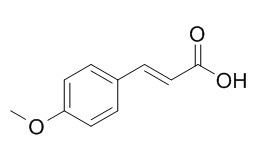4-Methoxycinnamic acid is a photosensitive compound, it shows various pharmacologic actions such as anti-cancer, hepatoprotective and antihyperglycemic activities, it also can stimulate insulin secretion from pancreatic β-cells by increasing Ca2+ influx via the L-type Ca2+ channels, but not through the closure of ATP-sensitive K+ channels. 4-Methoxycinnamic acid can strongly inhibit the diphenolase activity of mushroom tyrosinase, with the IC 50 value of 0.42 mM, and the inhibition is reversible.
The packaging of the product may have turned upside down during transportation, resulting in the natural compounds adhering to the neck or cap of the vial. take the vial out of its packaging and gently shake to let the compounds fall to the bottom of the vial. for liquid products, centrifuge at 200-500 RPM to gather the liquid at the bottom of the vial. try to avoid loss or contamination during handling.
US 8758864 B2[P]. 2014.
Photosensitive semiconductor nanocrystals, photosensitive composition comprising semiconductor nanocrystals and method for forming semiconductor nanocrystal pattern using the same[Reference:
WebLink]
4. The organic-inorganic hybrid electroluminescent device according to claim 1, wherein the compound containing a photosensitive functional group is selected from a group consisting of methacrylic acid, crotonic acid, vinylacetic acid, tiglic acid, 3,3-dimethylacrylic acid, trans-2-pentenoic acid, 4-pentenoic acid, trans-2-methyl-2-pentenoic acid, 2,2-dimethyl-4-pentenoic acid, trans-2-hexenoic acid, trans-3-hexenoic acid, 2-ethyl-2-hexenoic acid, 6-heptenoic acid, 2-octenoic acid, citronellic acid, undecylenic acid, myristoleic acid, palmitoleic acid, oleic acid, elaidic acid, cis-11-elcosenoic acid, euric acid, nervonic acid, trans-2,4-pentadienoic acid, 2,4-hexadienoic acid, 2,6-heptadienoic acid, geranic acid, linoleic acid, 11,14-eicosadienoic acid, cis-8,11,14-eicosatrienoic acid, arachidonic acid, cis-5,8,11,14,17-eicosapentaenoic acid, cis-4,7,10,13,16,19-docosahexaenoic acid, fumaric acid, maleic acid, itaconic acid, ciraconic acid, mesaconic acid, trans-glutaconic acid, trans-beta-hydromuconic acid, trans-traumatic acid, trans-muconic acid, cis-aconitic acid, trans-aconitic acid, cis-3-chloroacrylic acid, trans-3-chloroacrylic acid, 2-bromoacrylic acid, 2-(trifluoromethyl)acryl-ic acid, trans-styrylacetic acid, trans-cinnamic acid, alpha.-methylcinnamic acid, 2-methylcinnamic acid, 2-fluorocinnamic acid, 2-(trifluoromethyl)cinnamic acid, 2-chlorocinnamic acid, 2-methoxycinnamic acid, 2-hydroxycinnamic acid, 2-nitrocinnamic acid, 2-carboxycinnamic acid, trans-3-fluorocinnamic acid, 3-(trifluoromethyl)cinnamic acid, 3-chlorocinnamic acid, 3-bromocinnamic acid, 3-methoxycinnamic acid, 3-hydroxycinnamic acid, 3-nitrocinnamic acid, 4-methylcinnamic acid, 4-fluorocinnamic acid, trans-4-(trifluoromethyl)-cinnamic acid, 4-chlorocinnamic acid, 4-bromocinnamic acid, 4-Methoxycinnamic acid, 4-hydroxycinnamic acid, 4-nitrocinnamic acid, 3,3-dimethoxycinnamic acid, 4-vinylbenzoic acid, allyl methyl sulfide, allyl disulfide, diallyl amine, oleylamine, 3-amino-1-propanol vinyl ether, 4-chlorocinnamonitrile, 4-methoxycinnamonitrile, 3,4-dimethoxycinnamonitrile, 4-dimethylaminocinnamonitrile, acrylonitrile, allyl cyanide, crotononitrile, methacrylonitrile, cis-2-pentenenitrile, trans-3-pentenenitrile, 3,7-dimethyl-2,6-octadienenitrile, and 1,4-dicyano-2-butene.
Mol Cell Biochem. 2014 Sep;394(1-2):187-98.
Protective effect of p-methoxycinnamic acid, an active phenolic acid against 1,2-dimethylhydrazine-induced colon carcinogenesis: modulating biotransforming bacterial enzymes and xenobiotic metabolizing enzymes.[Pubmed:
24908112 ]
Objective of the study is to evaluate the modifying potential of p-methoxycinnamic acid (4-Methoxycinnamic acid,p-MCA), an active rice bran phenolic acid on biotransforming bacterial enzymes and xenobiotic metabolizing enzymes in 1,2-dimethylhydrazine-induced rat colon carcinogenesis.
METHODS AND RESULTS:
48 male albino wistar rats were divided into six groups. Group1 (control) received modified pellet diet and 0.1 % carboxymethylcellulose; group2 received modified pellet diet along with p-MCA (80 mg/kg b.wt. p.o.) everyday for 16 weeks; groups 3-6 received 1,2-dimethylhydrazine (DMH) (20 mg/kg b.wt.) subcutaneous injection once a week for the first 4 weeks, while groups 4-6 received p-MCA at three different doses of 20, 40 and 80 mg/kg b.wt. p.o. everyday for 16 weeks. A significant increase in carcinogen-activating enzymes (cytochrome P450, cytochrome b5, cytochrome P4502E1, NADH-cytochrome-b5-reductase and NADPH-cytochrome-P450 reductase) with concomitant decrease in phaseII enzymes, DT-Diaphorase, glutathione S-transferase, UDP-glucuronyl-transferase and gamma glutamyltransferase were observed in group3 compared to control. DMH treatment significantly increased the activities of feacal and colonic bacterial enzymes (β-glucosidase, β-galactosidase, β-glucuronidase, nitroreductase, sulphatase and mucinase). p-MCA supplementation (40 mg/kg b.wt) to carcinogen exposed rats inhibited these enzymes, which were near those of control rats.
CONCLUSIONS:
The formation of dysplastic aberrant crypt foci in the colon and the histopathological observations of the liver also supports our biochemical findings. p-MCA (40 mg/kg b.wt.) offers remarkable modulating efficacy of biotransforming bacterial and xenobiotic metabolizing enzymes in colon carcinogenesis.



